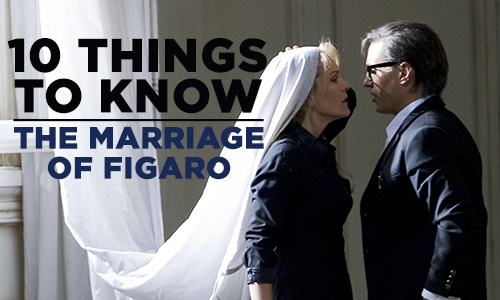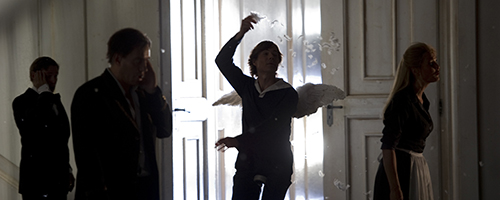-
10 Things to Know: The Marriage of Figaro
By Nikita GourskiPosted in Marriage of Figaro
1) Controversial source material
Mozart and Da Ponte’s opera is based on the play, La folle journée, ou Le Mariage de Figaro (completed in 1781, performed in 1784) by Pierre Beaumarchais, which was quite a controversial work. Written in 1781, it was banned in France by King Louis XVI, even though his wife Marie-Antoinette loved it. Louis was concerned about the play’s political message: the protagonist Figaro’s speeches suggested the aristocracy was corrupt, prone to abuses of power, and ultimately an illegitimate form of social organization. If that wasn’t enough, the play was also open to charges of immorality and licentiousness due to its sexual content. With all those ingredients in the mix, it is perhaps not surprising that when it was finally given a public performance in France in 1784, it was an enormous success and quickly became the most popular play of the 18th century.
2) Complicated, witty plot of social relations
The Marriage of Figaro is about four couples (the Count and Countess; Figaro and Susanna; Dr. Bartolo and Marcellina; and Cherubino and Barbarina) all trying to secure a combination of romantic satisfaction and financial security over the course of one hectic day. There are a lot of exits and entrances—doors, windows, and staircases see a lot of traffic—as well as cross-dressing, timely revelations, and misunderstanding, all kept at a fast and furious narrative pace.
3) Droit du seigneur
Key to the plot is the so-called droit du seigneur, an ancient right that may never have legally existed that allowed the lord of the house to have sex with any of his female servants on their wedding night. Mozart and Da Ponte, following Beaumarchais, use this device to set the central conflict in motion: although the Count has supposedly surrendered his droit du seigneur, he makes continuous advances on Susanna, who is a maidservant in his household. In league with the Countess and Figaro, Susanna works to outwit the Count at every step and foils his attempts.
4) The first ever truly human opera
Figaro is quite probably the very first important opera in history to turn its attention away from mythological and biblical stories and look at ordinary human beings. While there were prior depictions of common people in opera, these were usually farcical and one-dimensional characters, whereas Mozart’s opera has a depth of feeling for its subject that represents a wholly new development in the genre.

5) Mozart’s triumphant arrival as an opera composer
The Marriage of Figaro was a big success for Mozart at its premiere in Vienna in 1786, only two years after the play’s premiere. There were so many calls for encores that Joseph II (ruling monarch of the Hapsburg Empire), issued an edict banning ensemble encores in the interests of keeping the theatre hours reasonable and the management costs down.
6) This production is “perfection” (Bloomberg)
This new COC production was originally conceived as the headline event of the Salzburg Festival’s celebrations of Mozart’s 250th birthday. The renowned German director Claus Guth focused on the intensity of human desire, which is at the heart of the story, relocating the action from 18th-century Andalusia to fin-de-sècle Central Europe, and pulling from atmospheric influences like the stage plays of Ibsen and Strindberg, as well as the films of Ingmar Bergman. The production has been widely praised for “open[ing] up a new perspective on an opera that is normally staged as a lightweight, turbulent farce” (Zeit online).

7) Power of love
This production’s most striking directorial intervention comes in the form of a non-speaking character, Cherubim, who is costumed almost exactly like the page, Cherubino. Cherubim is invisible to the other characters and frequently manipulates them, pushing them together or pulling them apart, symbolizing the engine which drives Mozart’s complex musicodramatic creation: erotic attraction.
8) Upstairs, downstairs, inside, and out
While the exact time period remains ambiguous, the action is set in what could be the main hall of a 19th-century mansion. In the opera’s finale (traditionally set in a garden at night), the set is turned upside down, in continuity with the opera’s thematic content: the relationship between master and servant has been challenged, if not overturned, by Figaro and Susanna; love itself, in all its emotional messiness, has seemingly triumphed and displaced the ordering principles of reason; while erotic passion continues to modulate perception, subjective experience, and our interpretation of other selves.

9) Ensembles to die for
In Figaro, Mozart took ensembles—musical structures with lots of characters singing at once—to a historically unprecedented level of sophistication, emotional impact, and sensuality. Even among the greatest composers, Mozart’s ensembles stand out as uniquely accomplished. One of the best examples is to be found the finale of Act II of The Marriage of Figaro, in which seven musically independent parts are woven into one miraculous whole.
10) Figaro endures
Figaro has never left the repertory and endures today as a smart and witty exploration of human relationships, not to mention a wholly satisfying example of opera’s potential to fuse comedy, tragedy, poetry and a variety of musical writing into a mutually reinforcing, complete work of art.
Catch The Marriage of Figaro at the Four Seasons Centre from February 4 - 27, 2016! Get your tickets today here.Photo Credits (top - bottom): Marlis Petersen as Susanna and Erwin Schrott as Figaro. (l-r) Genia Kühmeier as the Countess, Katija Dragojevic as Cherubino and Marlis Petersen as Susanna. (l-r) Simon Keenlyside as Count Almaviva, Erwin Schrott as Figaro, Uli Kirsch as Cherubim and Marlis Petersen as Susanna. All photos from The Marriage of Figaro (Salzburg Festival, 2011), photos: Monika Rittershaus
